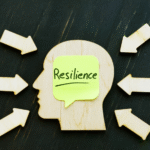We all have moments where we just want to sit in our frustration. When life feels unfair, emotions run high, and all you want to do is stew in the sadness, anger, or resentment. And honestly? That’s okay – for a little while.
In my last blog, “It Won’t Feel Like This Forever,” I explored the idea of riding the emotional wave: letting hard feelings pass without rushing to fix them. But sometimes, when the storm has settled just enough, there’s another step you can take. This post is about that step. The moment you reclaim your power by shifting your attitude.
This isn’t about toxic positivity or pretending you’re fine when you’re not. It’s about recognizing that you have a choice in how you respond, even when things feel hard.
1. Feeling vs. Feeding the Emotion
In any given day, we experience a range of emotions. Sometimes it’s something small that shakes us – like getting left out of a study group, someone not following through on a promise, or receiving unexpected criticism. And sometimes it’s something bigger.
It’s completely valid to feel hurt, disappointed, or angry. But eventually, you have to ask yourself:
“Am I feeling this emotion… or feeding it?”
We often stay in familiar emotional states because they validate our internal narrative. But the truth is, you often have more choice over your attitude than it feels in the moment. When you get criticism, instead of reacting with anger or spiralling into self-doubt, you can pause and ask:
Is there something I can learn from this?
Am I reacting to protect myself… or to understand?
Changing your mindset doesn’t mean the pain disappears – it means you’re not letting it drive you.
2. Cognitive Reframing: Changing the Lens
When you’re stuck in negative thoughts, it’s easy to fall into patterns like,
“No one likes me.”
“This always happens to me.”
“I’ll never be good enough.”
Cognitive reframing is the skill of challenging those thoughts and choosing to look at the situation from a different perspective. For example, if you weren’t invited to your friend’s study group, instead of thinking, “They don’t value me,” try:
“Maybe they didn’t realize I wanted to join. Maybe this is a chance to find people I feel more supported by.”
This is what “changing your attitude” really means – not ignoring the pain but refusing to let it be the whole story.
3. The Power of the Pause
Before you react. Pause.
Just a few seconds can help you shift from instinct to intention.
This space between stimulus and response is where change happens. It’s where you get to choose:
Do I keep spiralling?
Or do I anchor into who I want to be right now?
When it’s hard to know what to do, return to your values. Ask yourself:
- What kind of person do I want to be in this moment?
- If someone I loved were in this situation, what would I hope for them?
- How can I act in a way that brings peace, not regret?
Sometimes, choosing your attitude means walking away. Other times, it means showing grace or trying again with fresh energy.
Attitude isn’t just a reaction – it’s a conscious decision.
You may not always choose what happens to you, but you can choose what you do next.
So the next time you feel the spiral starting – pause, breathe, and ask:
- What story am I telling myself?
- Is this thought helping or hurting me?
- What shift do I want to make—right now, for me?
Because shift happens.
And when it does, you’ll be ready.







